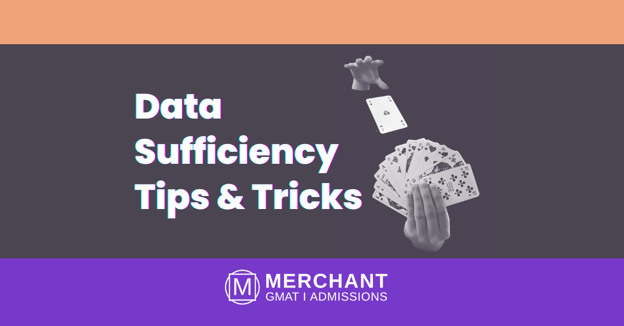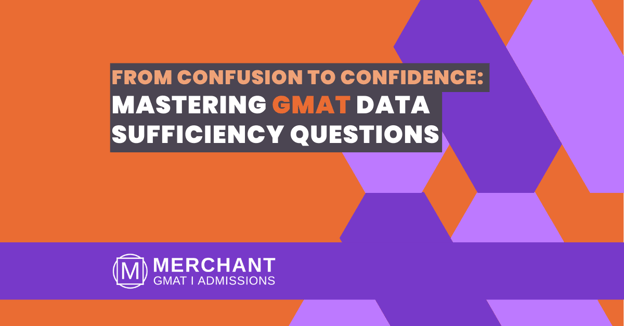Smaller, Easier, More Manageable: Our Guide to Data Sufficiency Questions

As any student who starts to prepare for the GMAT knows, the GMAT exam is not just a test that measures your math skills but more a test that measures your critical thinking and reasoning.
The Quant portion of the GMAT has 2 types of problems: Problem Solving questions and Data Sufficiency questions. These Data Sufficiency questions are the type of questions that the clever GMAT authors have built to test one’s critical thinking and decision making skills, which are important characteristics of a business school applicant. They are questions that present a problem followed by two statements & one must prove the statements sufficient or insufficient. They are confusing, lengthy, frustrating and unavoidable, as these data sufficiency questions compose about 25 – 30% of the quant test. However, here at Merchant GMAT, we have identified an efficient process that allows us to work through these types of questions with much more clarity and precision. Let’s take a look at an example….
Question: If the remainder is 2 when x is divided by 5, then x is divisible by 7?
Statement 1) x is a prime number
Statement 2) x+3 is a multiple of 10
Now, in order to tackle this problem, we are going to go through the 5 basic steps that break down the problem into pieces. Our Merchant philosophy is to always break things down into smaller components. As you would with any work project, you would break it down to smaller goals. Likewise, at the start of each day, you make small checklist items to make sure you have an overall productive day! We will use the same approach to a standard D.S problem.
Step 1: Label the problem
All Data Sufficiency problems can be broken down into two categories. Yes or No questions OR Value questions. In this case, we have a problem that says “is x divisible by 7?” This is clearly a yes or no question. This allows us to now understand the type of answer we are looking for.
Step 2: Identifying keywords or constraints about x
In this step, we are analyzing characteristics about what x could be. Sometimes they tell us it has to be an integer or a positive number. In this case, it says “remainder is 2 when x is divided by 5.” So what does that mean? If I wrote it out into “mathematical terms, it would look something like this:

Now, let’s think what values x could be to make this equation true. 7 is true for this question. So is 12 and 17. So what do these three numbers have in common? Well, starting with 7, we are increasing it by 5 each time to result in 12 & 17. Therefore we can say
x : {2, 7, 12, 17, 22…} increases by 5
Step 3: Simplify and Understand the Prompt
In step 3, we are still focusing just on the question description but we are now ready to look into the question itself. “Is x divisible by 7?” Based on the information I learned in Step 2, I see that within my list of options, 7 is the only number that would give me a “yes” to that question compared to 2, 12, 17, 22, which are not divisible by 7 and would give me a “no.” Therefore, now, before you have even read statement 1 or 2, you have more clarity on what kind of numbers will give you yes vs no to your question.
Although we have spent a good amount of time on the first 3 steps, they should only take you 10 seconds each in “test mode.” These steps are crucial, as you have gained a lot of insight and clarity to help you understand the question. As you move forward to look at the statements, you have a better understanding of what you are looking for.
Step 4: Analyze Statement 1
When moving to the statements, we must remember what we are looking for. If we continue to get all “yes” responses, then the statement is sufficient. If we continue to get all “no” responses, then the statement is also sufficient. This is the part that is counter-intuitive for some people. The goal is to get a confident yes or no answer from each statement. If I get a yes AND no answer, then we can positively say the statement is insufficient.
So let’s take a look, statement 1 says: “x is a prime number” – we will use this as an additional piece of information to our original question. We had…
x : {2, 7, 12, 17, 22…} increases by 5
From our list of numbers, we have that 2, 7, 17 are all prime numbers but 12 and 22 are not. So we can not test these numbers to prove the statement sufficient or insufficient. We will test the other remaining numbers: 2, 7, 17 against our question “is x divisible by 7?” In order to keep our information organized we will make a “Clarity Matrix” as such:
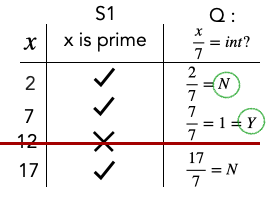
The first column in the matrix is values of x for you to test. As you can see, 12 is scratched out because it does not follow the Statement that x must be a prime number. That is also the purpose of the second column, to make sure that you are testing values of x that are in line with the question as well as the statement. Finally, the last column is to test the actual answer to the question. As mentioned earlier, we know that 7 will always give me a yes, but every other value will be a no. Therefore this statement is insufficient.
Step 5: Analyze Statement 2
After analyzing statement 1 alone, we must also look now at statement #2 alone. Statement 2 says “x+3 is a multiple of 10.” This is a bit trickier… that means that when you look back at the list of numbers you made in step 2, when we add 3 to that number it must equal 10 or 20 or 30 etc. Now, if you were to create a clarity matrix again, just go down your list x : {2, 7, 12, 17, 22…} and test each value to see what happens.
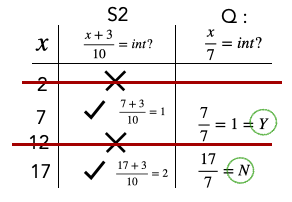
As you can see from the matrix, 2 and 12 are values that do not comply with our statement 2 but 7 and 17 do! Then when I move onto the third column that answers by question, we get that 7 is yes but 17 is no. Therefore, this statement is also insufficient.
Bonus Step 6: Analyze Statement 1 and 2 together
Whenever Statement 1 and 2 is insufficient is the only time you analyze both statements together. Once we get to this point, you are usually tired and exhausted, but don’t be discouraged because you have learned a lot along the way! In this case we see that in both S1 and S2, 7 complied with both and gave us a “yes” result in our last column. On the other hand, we also have number 17 that complied with both statements but gave us a “no” in both statements. This allows us to deduct that if we look at both statements together, we can test both of these numbers and end up with the same results: a yes and a no answer, thus insufficient. If this is not clear, you can also create a third clarity matrix and go through the same process.
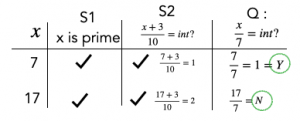
Therefore, we have concluded that with a Yes and No value at the end that both statements together are insufficient.This would be answer choice E, Statement 1 and statement 2 together are not sufficient.
Written by Jessica Hunek, a Quant Coach here at Merchant GMAT & Admissions.
Ready to Start?
Fill out the form, and a member of the Merchant Sales Team will be in contact with you shortly to discuss your MBA journey



